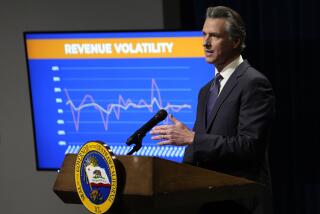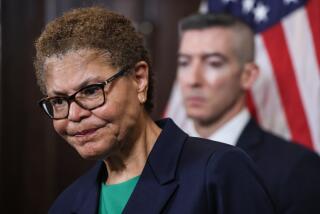State’s Budget Mess: Will It Ever Clear Up?
- Share via
SACRAMENTO — When California’s Republican governor and the Democrats who control the Legislature struck a deal to pass the budget in 1991, they declared that they had erased a $14-billion shortfall and put the state on the road to recovery.
That road turned out to be a dead-end street.
A recession that the state’s leaders assumed would be short instead became a major economic downturn. What they perceived as a momentary gap between tax revenue and spending was in reality a long-term imbalance that dogs the state to this day.
Now it seems clear that the next governor--either a reelected Republican Pete Wilson or his Democratic challenger, Kathleen Brown--will confront stark choices as he or she prepares a proposed budget that must be delivered to the Legislature by Jan. 10.
On one level, the options are simple: either raise taxes, cut the cost of services, or enact some combination of the two.
But in a deeper sense, California’s leaders face profound decisions about the future of a state that once was a model for the nation in many areas but now struggles to reconcile an ever-rising demand for public services and an electorate reluctant to pay for them.
The public schools, losing ground to inflation, increasingly must rely on donations from parents to buy everything from pencils to toilet tissue. The universities, which once charged only nominal fees, now cost thousands of dollars a year. Highways, water systems and parks haven’t kept up with the demands of a growing population. And the safety net for those who fall through the cracks is far less generous than it once was.
Some question whether the state’s leaders have the political will to solve these daunting challenges. But even those who are eager to take on the job say they are hamstrung by an array of restrictions that a suspicious electorate has enacted over the years to limit the flexibility of those they elect to govern the state.
As a result of all these factors, the state has careened from one budget crisis to another, raising taxes one year, cutting services the next, shifting property tax and sales tax revenue around to plug fiscal leaks in local government and the schools. One thing the state has not done is balance the budget.
Not since the Depression has the state run up this much red ink.
“There is no fiscal policy in the state of California,” says Assemblyman Philip Isenberg of Sacramento, a centrist Democrat. “We’ve adopted a deliberate and intentional policy to spend money we don’t have--and to borrow to pay for it. It doesn’t take a genius to figure that one out.”
The 1993-94 fiscal year ended in June with a deficit of nearly $2 billion. To put that figure in perspective, consider that the state could cut $200 per student from school funding, release 10,000 felons from the prisons and cut welfare grants by 20%--and still not erase its shortfall.
It may not be surprising, then, that the election-year budget adopted by the Legislature and signed by Gov. Pete Wilson in July did little to bring the state’s books closer to balancing. By the middle of 1996, in fact, the deficit is expected to grow to more than $3 billion.
That’s a far cry from 1987, when the state’s revenues were growing so fast that the constitutional spending limit forced the rebate of more than $1 billion to taxpayers.
Between 1987 and 1991, the state’s general fund tax receipts kept growing at a 4% annual clip. But spending climbed even faster, at a rate of more than 6%. Welfare caseloads, subsidized health care rolls and the number of state prison inmates all were growing faster than either the economy or the state’s population.
In three out of four years, the government spent more money than it took in. And those were the good times.
Then the bottom fell out of the state’s economy, and the budget went south with it.
A worldwide recession coupled with deep reductions in federal military spending cost the state a half million jobs--and the taxes those wage earners would have been paying. In 1992, per capita personal income in California fell for the first time in half a century, an ominous signal of just how bleak things had become in the state.
At first, most policy-makers thought California was in the midst of a typical slump in the business cycle that would last a year or so.
Wilson, in his first year in office, tried to bridge the gap with a combination of tax increases, budget cuts and onetime bookkeeping shifts. The governor and the Legislature raised the income and sales taxes and slapped higher levies on automobiles and alcohol while raising college fees, cutting welfare grants and suspending automatic cost-of-living increases.
These steps reduced the shortfall, but not by much.
In the following year’s budget, Wilson and the Legislature avoided tax increases, shifted part of the problem to local government, held the line on education spending and took another slice out of health and social services.
But these measures also failed to erase the stubborn shortfall, and since then the state has been rolling much of its deficit forward from one year to the next while trying to keep it from growing any larger. The current budget is financed with the help of billions in loans that the state, as of now, lacks the resources to repay.
The mounting debt, while viewed widely as fiscally irresponsible, probably represents an accurate reading by politicians of the one fiscal course they can chart that will alienate the fewest voters.
Judging from the plunge in Wilson’s public approval rating after the huge 1991 tax increase, the electorate is in no mood to hand over more of its income to the government. But the alternative--cutting services--is no more popular.
“Citizens want something for nothing,” says John Ellwood, a professor of public policy at UC Berkeley. “They have been led by public officials of both parties to think they can get more services without raising taxes.”
At the same time, policy-makers have been given less freedom to make fiscal decisions.
In 1978, voters passed Proposition 13, which capped property taxes at 1% of assessed values, limited increases and required a two-thirds vote of the Legislature to raise taxes.
Ten years later came Proposition 98, which sets aside about 40% of the budget for kindergarten through community college education programs. It takes a two-thirds vote of the Legislature to suspend that requirement, and even then, any money that is diverted must be repaid to the schools when good times return.
Other restrictions written into law: Revenue from a 25-cent-a-pack tobacco tax is dedicated mainly for health care for the poor. Motor vehicle license fees must go to local government. Gasoline taxes are for roads. And so on.
While the general fund, which pays for most programs, this year amounts to about $42 billion, another $12 billion is set aside in special pots of money that cannot be diverted without changing the law, often with the approval of voters.
Much of the money not restricted by state law must be spent according to the federal dictates that come when the state accepts money from Washington for programs such as Medi-Cal and Aid to Families with Dependent Children.
The courts, meanwhile, already are telling the state how much it must spend on dental care for the poor and may soon set policy for the health care of state prison inmates.
“The problem is that in a situation of fiscal emergency, the state has one hand and four fingers tied behind its back,” said Tracy Westin, executive director of the California Citizens Budget Commission, a self-appointed group reviewing the budget process.
Westin added: “The state doesn’t have enough information to make intelligent decisions and doesn’t have enough flexibility to make rational decisions. It’s in a straitjacket.”
Others say the fractious administration of many government programs makes it difficult to improve their efficiency. The state and federal governments, for example, split the tab for welfare grants and set most of the rules, but the program is run by the counties. The people closest to the service, in other words, are those who have the least to do with paying for it.
So if you think welfare needs fixing, do you go to the counties that offer the service or the state, which sets the grant levels, or Congress, which pays for half of it?
“The connection between spending and results has become very difficult for citizens to ascertain,” said Elizabeth Hill, the nonpartisan state legislative analyst.
The fiscal situation has gotten so bad that many people believe the public is ready to accept a fundamental restructuring of the way government finance works in California. A bipartisan commission recently began a review of the state Constitution that is expected to include a close look at ideas to help policy-makers fix the budget mess.
“Our elected officials need to be given the freedom to fund state programs at whatever level they believe appropriate, and then they ought to be held accountable by the voters for the decisions that they’ve made,” said Steven Merksamer, who got a firsthand look at the problem as chief of staff to former Gov. George Deukmejian.
But any changes in the process will come too late to help whoever wins this governor’s race fashion the next budget. It probably will be at least 1996 before any revisions can be put before the voters. Even then, getting enough political support to make such changes may prove difficult.
Assemblyman Isenberg said he fears the problem is so bad as to be almost insoluble. The state will be lucky to be back on its feet before the next recession hits, he says.
“The financial consequences of our irresponsibility are going to haunt the next governor for the next four years,” he said. “Most of the money that will come from a modest economic recovery will be used to pay off old debt. We won’t be able to do anything new or better or different without some very bold steps.”
About This Series
In the heat of a gubernatorial campaign, the candidates sometimes dwell on matters that have little to do with the larger problems facing Californians in the years ahead. This series looks beyond the rhetoric. The initial story set the stage by exploring the limits--and possibilities--of gubernatorial power. Other installments in the series:
* Earlier this month: The living conditions of California’s poorest citizens--and what they augur for the state’s future.
* Yesterday: Are demographic forces reshaping California more quickly than the political system can react?
* Today: Can the state government solve its budget problems and provide for future growth?
* Economy and education: Are California’s schools providing an underpinning for the state’s economic future?
* Environment: How will California balance environmental protection against the pressures of economic need?
State of the State: the Budget
REALITY
* Deficits: State spending has exceeded revenue in six of the past seven years.
* Debt: The state will borrow $7 billion to finance its budget over the next two years but lacks the resources to pay it all back.
* Credit: The state’s credit rating has been downgraded by Wall Street, forcing taxpayers to pay more when the state borrows to cover its deficits.
* Consequences: The budget remains out of balance despite a record tax increase in 1991, cuts to local government, universities, and health and welfare services to the poor, and austere funding levels that have forced kindergarten through community college education to lose ground to inflation.
RHETORIC
KATHLEEN BROWN
“Fairness, it seems to me, ought to be a fundamental principle in balancing the budget. Pete Wilson has balanced the budget not only on the backs of higher education but also on the poor.”
“No new taxes. We cannot afford new taxes in this recessionary environment.”
“Economic recovery cannot be achieved through collective denials of this deficit. It will only be realized when our leaders tell the truth to California’s taxpayers and offer responsible, common sense solutions that will help us begin building for the economic prosperity the people of California expect and deserve.”
PROPOSALS
* Roll all of the state’s short-term debt into a single bond that would be repaid over five years with annual payments of about $600 million.
* Extend for five years an income tax surcharge on wealthiest California residents that is due to expire at the end of 1995.
* Eliminate tax deductions for lobbying expenses and club dues, extend sales tax to catalogues printed in California, withhold state taxes from payments to independent contractors as is now done with salary and wages.
* Cut welfare grants 5%.
* Cut 3% a year from projected growth in state programs not protected by the Constitution--including prisons and higher education.
PETE WILSON
“When I took office four years ago, our state budget was a runaway train headed for a wreck. We turned it around. We haven’t just slowed the growth of government, we actually cut the size of government.”
“We were on auto-pilot spending. We’ve cut spending by more than any state in history.”
“We have sent a clear message to the citizens of this state that their representatives understand that partisan differences must be put aside to work for the common good. And we have demonstrated to the investment community that we can avoid the kind of political gridlock that could have put the state’s financial standing in jeopardy.”
PROPOSALS
* Eliminate certain Medi-Cal services, including dental care, which the state provides but which the federal government does not require as part of the state’s health care program for the poor.
* Reduce welfare grants from $607 monthly to $464 for a family of three with an able-bodied adult receiving aid for six months or more.
* Allow an income tax surcharge on wealthiest Californians to expire on schedule at the end of 1995.
* Deny public services to illegal immigrants, except for emergency health care, and demand reimbursement from the federal government for the state’s cost of serving undocumented immigrants.
State Finances (In billions of dollars)
1996-1997* Spending: $49.3 Revenues: $44.9 Spending figures for 1992-93 include “loans” to public schools
* Projected
More to Read
Get the L.A. Times Politics newsletter
Deeply reported insights into legislation, politics and policy from Sacramento, Washington and beyond. In your inbox twice per week.
You may occasionally receive promotional content from the Los Angeles Times.










